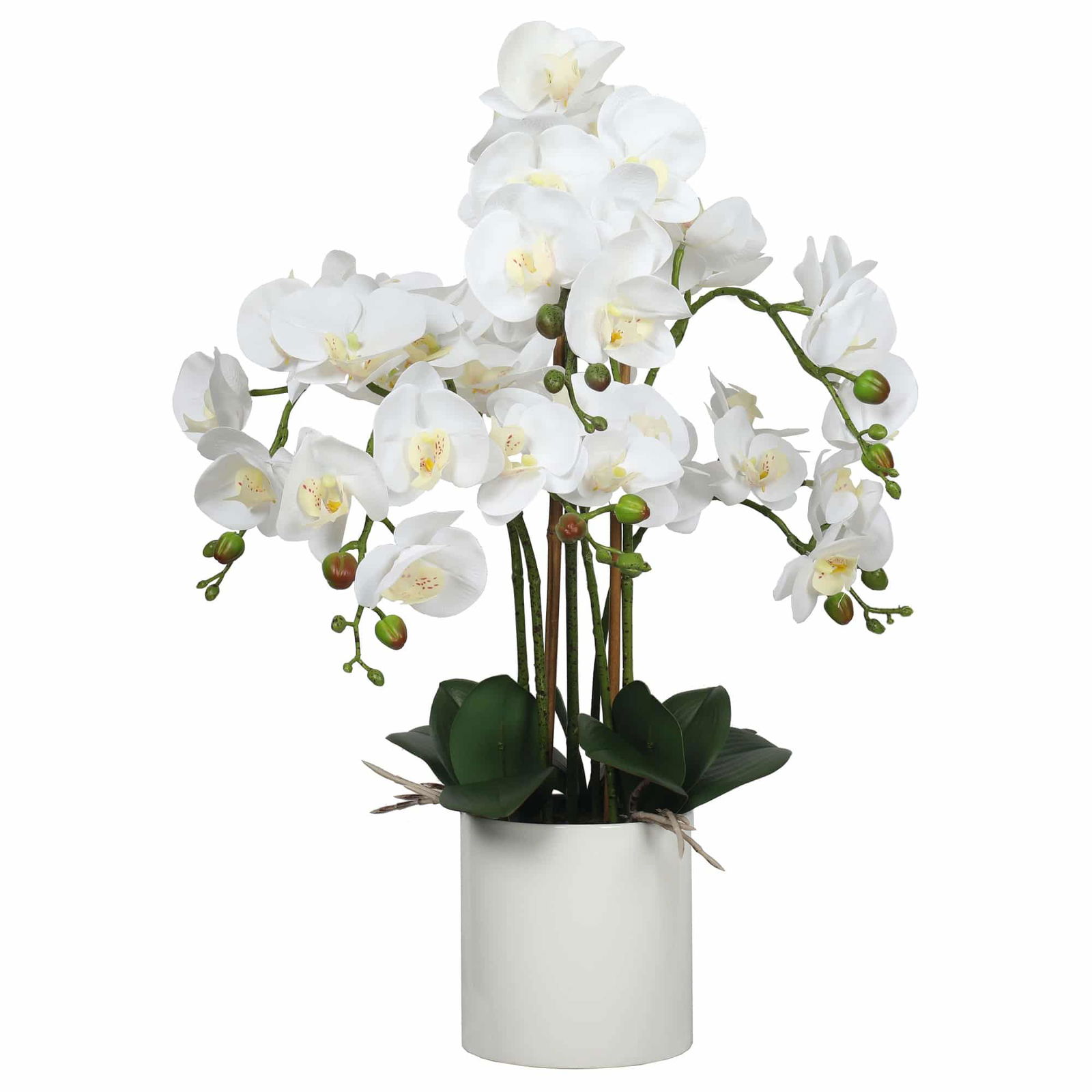Faux white orchid plants, meticulously crafted to mimic nature’s beauty, offer a touch of botanical elegance to any space. These artificial wonders, born from a blend of art and science, have captivated home decorators and plant enthusiasts alike.
From their origins to their diverse applications, this guide delves into the fascinating world of faux white orchid plants, providing practical tips and insights to help you embrace their timeless charm.
Overview of Faux White Orchid Plants

Faux white orchid plants have become increasingly popular in recent years as a low-maintenance and cost-effective alternative to live orchids. They are meticulously crafted to mimic the delicate beauty of natural white orchids, offering a realistic and elegant touch to any space.
The origins of faux white orchid plants can be traced back to the Victorian era, when artificial flowers were highly prized for their durability and affordability. Today, these plants are primarily produced using high-quality materials such as silk, latex, and polyurethane, which allow for intricate detailing and a lifelike appearance.
Materials Used in Production
The materials used in the production of faux white orchid plants play a crucial role in determining their quality and durability. Silk is a popular choice due to its soft, luxurious texture and ability to capture the delicate petals and sepals of orchids. Latex is often used for the stems and leaves, providing flexibility and a realistic appearance. Polyurethane is a versatile material that can be molded into various shapes and textures, making it suitable for creating intricate details such as the orchid’s central column and lip.
Types of Faux White Orchid Plants
Faux white orchid plants are available in a wide range of styles and sizes to suit different tastes and décor preferences. Some of the most popular types include:
- Phalaenopsis: This is the most common type of faux orchid plant, known for its large, butterfly-like flowers.
- Dendrobium: Dendrobium orchids feature clusters of smaller flowers along their stems.
- Cattleya: Cattleya orchids are characterized by their large, showy flowers with ruffled petals.
Advantages of Faux White Orchid Plants
Faux white orchid plants offer several advantages over live orchids, including:
- Low maintenance: They do not require watering, fertilizing, or pruning, making them ideal for busy individuals or those with limited gardening experience.
- Durability: Faux orchids are made from durable materials that can withstand fading, tearing, and breakage, ensuring they retain their beauty for years to come.
- Cost-effective: Faux orchids are significantly less expensive than live orchids, making them a more budget-friendly option.
Disadvantages of Faux White Orchid Plants
Despite their advantages, faux white orchid plants also have some disadvantages:
- Lack of fragrance: Unlike live orchids, faux orchids do not emit any fragrance.
- Limited variety: While there is a wide range of faux orchid plants available, they may not offer the same level of variety as live orchids.
- Environmental impact: Faux orchids are made from synthetic materials, which may not be biodegradable and can contribute to landfill waste.
Styling and Decor with Faux White Orchid Plants

Faux white orchid plants offer a versatile and elegant touch to any home decor style. Their realistic appearance and low maintenance make them an ideal choice for those who appreciate the beauty of orchids without the hassle of caring for live plants.
When styling with faux white orchid plants, consider the size, shape, and color of the plant in relation to the space and decor style. Larger plants with cascading blooms make a statement in spacious rooms, while smaller plants with delicate blooms are suitable for smaller spaces or as accents.
Choosing the Right Size and Shape
The size and shape of the faux white orchid plant should complement the scale and style of the room. For example, a tall, slender plant with cascading blooms can add height and drama to a large living room, while a smaller, more compact plant with delicate blooms can add a touch of elegance to a bedroom or bathroom.
Choosing the Right Color, Faux white orchid plant
Faux white orchid plants come in a variety of shades, from pure white to ivory and cream. Choose a color that complements the existing decor and creates the desired ambiance. Pure white orchids offer a classic and timeless look, while ivory and cream orchids add a touch of warmth and softness.
Creating Unique Arrangements and Displays
Faux white orchid plants can be used to create a variety of unique arrangements and displays. Consider using different sizes and shapes of plants to create a dynamic and visually interesting display. Place plants in vases, baskets, or other containers to add height and texture. You can also use faux white orchid plants to create centerpieces, garlands, or wall hangings.
Care and Maintenance of Faux White Orchid Plants

Faux white orchid plants require minimal care and maintenance, making them an ideal choice for those who want the beauty of orchids without the hassle of caring for live plants. Here are some tips for keeping your faux white orchid plants looking their best:
Cleaning and Dusting
Faux white orchid plants can accumulate dust over time, so it’s important to clean them regularly. Use a soft, dry cloth to gently wipe down the leaves and flowers. You can also use a soft brush to remove any stubborn dust or debris. Avoid using harsh chemicals or detergents, as these can damage the plant’s materials.
Storing
When not in use, store your faux white orchid plant in a cool, dry place away from direct sunlight. This will help to prevent the plant from fading or becoming damaged. You can wrap the plant in a plastic bag or box to protect it from dust and moisture.
Lifespan and Durability
Faux white orchid plants are highly durable and can last for many years with proper care. The materials used to make these plants are resistant to fading, moisture, and pests. However, it’s important to avoid placing the plant in direct sunlight, as this can cause the colors to fade over time.